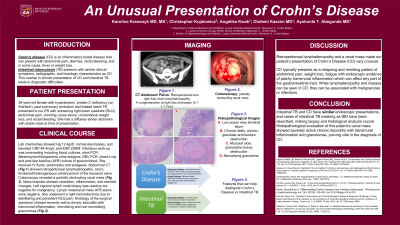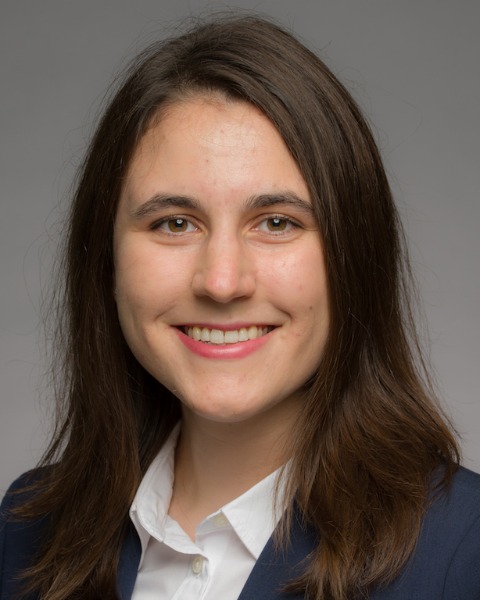Tuesday Poster Session
Category: IBD
P3655 - An Unusual Presentation of Crohn’s Disease
Tuesday, October 24, 2023
10:30 AM - 4:00 PM PT
Location: Exhibit Hall

Has Audio

Karolina Krawczyk, MD, MS
Loyola University Medical Center
Maywood, IL
Presenting Author(s)
Karolina Krawczyk, MD, MS1, Christopher Kujalowicz, 2, Angelika Kwak, 2, Olufemi Kassim, MD1, Ayokunle T.. Abegunde, MD1
1Loyola University Medical Center, Maywood, IL; 2Loyola University Chicago Stritch School of Medicine, Maywood, IL
Introduction: Crohn's disease (CD) can present with abdominal pain, diarrhea, rectal bleeding, and in some cases, fever or weight loss. Intestinal tuberculosis (TB) presents with similar clinical symptoms, radiographic, and histologic characteristics as CD. This overlap in clinical presentation of CD and intestinal TB leads to diagnostic difficulties.
Case Description/Methods: A 39-year-old female with hypertension, protein-C deficiency (on warfarin), past pulmonary embolism and treated latent TB presented to the emergency department with a few days of worsening right lower quadrant (RLQ) abdominal pain, vomiting, loose stools, unintentional weight loss, and rectal bleeding. She had a diffusely tender abdomen with stable vital signs. Lab chemistries showed Hg 12.4 g/dl, normal electrolytes, and an elevated CRP 84.4 mg/L and ESR 23 MM. Infectious work-up was unrevealing including blood cultures, stool PCR, Blastomyces and Histoplasma urine antigens, EBV PCR, chest x-ray and acid-fast bacillus (AFB) culture of sputum and blood. She received intravenous fluids, antiemetics and analgesia. Abdominal computed tomography (CT) showed retroperitoneal lymphadenopathy, and a thickened/heterogeneous enhancement of the ileocecal valve. Colonoscopy revealed a partially obstructing cecal mass. Biopsies of the mass showed ulceration, inflammation, and reactive changes. A left inguinal lymph node biopsy was reactive but negative for malignancy. AFB stains of the lymph node and cecal mass were negative. Our patient underwent a right hemicolectomy due to her debilitating and persistent RLQ pain. Histology of the surgical specimen demonstrated severely active chronic ileocolitis with transmural inflammation, necrotizing and non-necrotizing granulomas.
Discussion: Retroperitoneal lymphadenopathy and a cecal mass made our patient’s presentation of CD unusual. CD typically presents as a relapsing and remitting pattern of abdominal pain, weight loss, fatigue with endoscopic evidence of patchy transmural inflammation which can affect any part of the gastrointestinal tract. While lymphadenopathy and masses can be seen in CD, they can be associated with malignancies or infections. Intestinal TB and CD have similar endoscopic presentations, and cases of intestinal TB masking as IBD have been described, making biopsy and histological analysis crucial. Histopathological evaluation of this patient’s cecal mass showed severely active chronic ileocolitis with transmural inflammation and granulomas, proving vital in the diagnosis of CD.
Disclosures:
Karolina Krawczyk, MD, MS1, Christopher Kujalowicz, 2, Angelika Kwak, 2, Olufemi Kassim, MD1, Ayokunle T.. Abegunde, MD1. P3655 - An Unusual Presentation of Crohn’s Disease, ACG 2023 Annual Scientific Meeting Abstracts. Vancouver, BC, Canada: American College of Gastroenterology.
1Loyola University Medical Center, Maywood, IL; 2Loyola University Chicago Stritch School of Medicine, Maywood, IL
Introduction: Crohn's disease (CD) can present with abdominal pain, diarrhea, rectal bleeding, and in some cases, fever or weight loss. Intestinal tuberculosis (TB) presents with similar clinical symptoms, radiographic, and histologic characteristics as CD. This overlap in clinical presentation of CD and intestinal TB leads to diagnostic difficulties.
Case Description/Methods: A 39-year-old female with hypertension, protein-C deficiency (on warfarin), past pulmonary embolism and treated latent TB presented to the emergency department with a few days of worsening right lower quadrant (RLQ) abdominal pain, vomiting, loose stools, unintentional weight loss, and rectal bleeding. She had a diffusely tender abdomen with stable vital signs. Lab chemistries showed Hg 12.4 g/dl, normal electrolytes, and an elevated CRP 84.4 mg/L and ESR 23 MM. Infectious work-up was unrevealing including blood cultures, stool PCR, Blastomyces and Histoplasma urine antigens, EBV PCR, chest x-ray and acid-fast bacillus (AFB) culture of sputum and blood. She received intravenous fluids, antiemetics and analgesia. Abdominal computed tomography (CT) showed retroperitoneal lymphadenopathy, and a thickened/heterogeneous enhancement of the ileocecal valve. Colonoscopy revealed a partially obstructing cecal mass. Biopsies of the mass showed ulceration, inflammation, and reactive changes. A left inguinal lymph node biopsy was reactive but negative for malignancy. AFB stains of the lymph node and cecal mass were negative. Our patient underwent a right hemicolectomy due to her debilitating and persistent RLQ pain. Histology of the surgical specimen demonstrated severely active chronic ileocolitis with transmural inflammation, necrotizing and non-necrotizing granulomas.
Discussion: Retroperitoneal lymphadenopathy and a cecal mass made our patient’s presentation of CD unusual. CD typically presents as a relapsing and remitting pattern of abdominal pain, weight loss, fatigue with endoscopic evidence of patchy transmural inflammation which can affect any part of the gastrointestinal tract. While lymphadenopathy and masses can be seen in CD, they can be associated with malignancies or infections. Intestinal TB and CD have similar endoscopic presentations, and cases of intestinal TB masking as IBD have been described, making biopsy and histological analysis crucial. Histopathological evaluation of this patient’s cecal mass showed severely active chronic ileocolitis with transmural inflammation and granulomas, proving vital in the diagnosis of CD.
Disclosures:
Karolina Krawczyk indicated no relevant financial relationships.
Christopher Kujalowicz indicated no relevant financial relationships.
Angelika Kwak indicated no relevant financial relationships.
Olufemi Kassim indicated no relevant financial relationships.
Ayokunle Abegunde indicated no relevant financial relationships.
Karolina Krawczyk, MD, MS1, Christopher Kujalowicz, 2, Angelika Kwak, 2, Olufemi Kassim, MD1, Ayokunle T.. Abegunde, MD1. P3655 - An Unusual Presentation of Crohn’s Disease, ACG 2023 Annual Scientific Meeting Abstracts. Vancouver, BC, Canada: American College of Gastroenterology.
